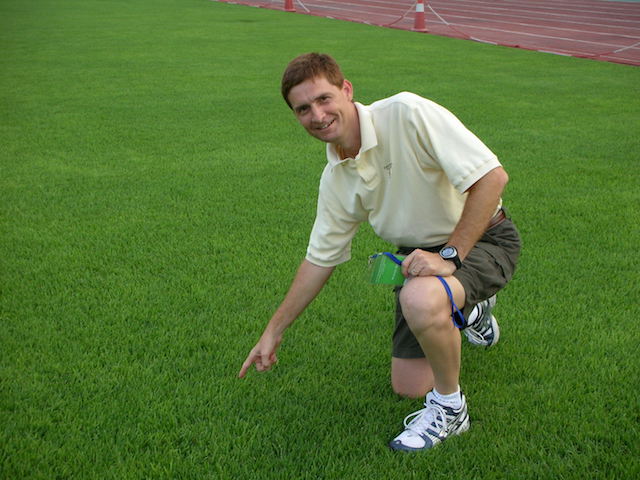Q: Our school hosted a band completion with 23 bands and more than 2,300 students. The field they used was damp and it rained during the event. About 5,000 square feet of the field was totally destroyed. We have soccer games in a week and the coaches want something done. With it being mid-October, I am not sure what we can do. The field looks like a hay feeding area in a pasture. What are our options? – A North Carolina high school
A: If any of you are like me and grew up on a cattle farm, I knew what this field looked like even before I opened up the pictures that were attached to the email. “The field looks like a hay feeding area in a pasture” was so descriptive to me that I did not even need to see pictures.
As I was typing my response, I could not but help to think about how different this scenario would be if this was a professional-level field that had been destroyed during the season and ownership was worried about the potential for million dollar athletes getting hurt due to the field. When big money is in both sides of the equation, options are typically viewed differently.
For the quickest and best fix, the school administrator could call a vendor that sells and installs “game-ready” sod. A contractor could mobilize a large fraise mower and accompanying equipment to cut out the damaged area. By the time the damaged area was removed semi-tractor trailers would arrive and the thick-cut sod would be off-loaded and expertly placed in the cutout area. It could be accomplished so quickly that the high school teams would probably only miss a day or two of practice plus have a great playing surface. But this would be an expensive option and most high schools have so little money to spend on their fields.
I went ahead and presented the fraise mowing/thick cut sod option because I felt the school administration should hear a range of options for their consideration. I then quickly moved to alternatives I thought they could accomplish on a minimum budget. Before going over suggested options, I made it clear that with temperatures at night in the mid-50s and highs in the upper 70s to low 80s, there was not much hope that their bermudagrass would recover within a week. Also, installation of sod cut at traditional thickness would have (dangerously) poor stability with only a week of establishment given the current weather forecast.
My next thoughts centered on overseeding. I figured that if they were already planning on overseeding the field then it would be worth the effort to get the seed out as soon as possible. Although the seed would start germinating in a few days, heavy play would damage a lot of the young seedlings. They would need to add more seed after games until they built up to a surviving perennial ryegrass population. But I would only do this if they were planning on overseeding anyway. While I do not think overseeding would solve all their problems, it could help dry their muddy field, provide some soil stabilization, and provide additional traction for athletes.
If overseeding was not something they had planned or were willing to try, I suggested that they at least go out with a light fertilization (0.3 to 0.5 pounds of N per 1000 square feet) of soluble N as soon as possible. With sunshine warming the surface, the nutrition may encourage a small growth spurt for the bermudagrass. Along with the fertilizer, I suggested they find a lightweight roller (up to 1 ton) and begin rolling the field. This can push out some surface moisture, firm soil around bermudagrass propagules, and generally provide a more stable soil surface for play. The area should be rolled again after games to try to keep the soil around bermudagrass nodes so it may have a chance to take hold. Any damage from rolling can be addressed after the season. I thought short of moving the games to other fields, that these were their best options. /ST/
Update: I wrote this column the day after making my suggestions to the school. A couple of days later, I followed up with my school contact to see what they had decided to do about the field. Their response surprised me. He said that after considering my comments, they found a contractor to fraise mow the damage out of the field and they were presently in the process of installing the thick-cut sod. I never thought they would use that option. I had even felt bad about putting it on the table for their consideration. I did not ask about cost or who was paying the bill, but obviously the school administration figured the results would be worth the expense. Go team!
Questions?
Send them to Grady Miller at North Carolina State University, Box 7620, Raleigh, NC 27695-7620, or e-mail grady_miller@ncsu.edu
Or, send your question to Pamela Sherratt at 202 Kottman Hall, 2001 Coffey Road, Columbus, OH 43210 or sherratt.1@osu.edu


